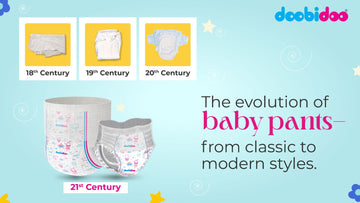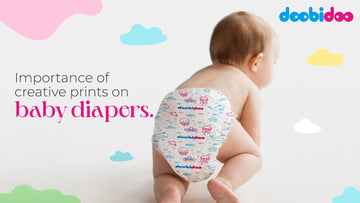The evolution of baby pants - from classic to modern styles
by Namrata Sekhani on Sep 25, 2023
Evolution of Baby Diapers: A Journey from the 18th Century to Today
As any parent would attest, baby diapers have become indispensable to child-rearing. The evolution of baby diapers spans several centuries and has seen remarkable transformations, from rudimentary cloth wraps to highly advanced disposable designs. This blog explores the fascinating history of baby diapers, delving into their humble beginnings in the 18th century and tracing their journey to the modern innovations we know today.
18th Century - The Age of Simplicity
In the 18th century, baby diapers were a far cry from the convenient products we have today. Mothers mainly relied on basic cloth squares, often made from cotton or linen, to swaddle their infants. These cloth wraps required frequent washing and posed challenges in terms of leakage and absorbency. Nevertheless, they laid the groundwork for the future of diapering.
19th Century - The Rise of Safety Pins
The 19th century saw the advent of safety pins, which revolutionized diapering. This simple yet ingenious invention made securing cloth diapers easier, ensuring they stayed in place while offering some level of convenience. However, the issue of frequent washing persisted, as these diapers lacked any form of absorbent padding.
20th Century - The Emergence of Disposable Diapers
The 20th century marked a pivotal moment in the history of baby diapers with the introduction of disposable diapers. In the 1940s, Marion Donovan, a mother herself, designed a waterproof cover for cloth diapers using a shower curtain. Her invention laid the foundation for disposable diaper development.
In 1961, Pampers, the first disposable diaper, hit the market, developed by chemical engineer Victor Mills. Pampers offered a disposable absorbent pad with a plastic outer cover, drastically reducing the burden of washing and making diapering more convenient for parents. The concept caught on rapidly, and by the 1980s, disposable diapers became the norm for most families.
21st Century - Innovations and Sustainability
With the turn of the 21st century, the focus on innovation and environmental consciousness brought about significant changes in the diaper industry. Companies began developing diapers with improved materials, better absorbency, and breathable designs to enhance baby comfort.
Furthermore, the ecological impact of disposable diapers led to the rise of eco-friendly alternatives. Reusable cloth diapers made a comeback, utilizing sustainable fabrics and reducing waste. Some parents even opted for compostable or biodegradable disposable diapers to minimize environmental harm.
Conclusion
The evolution of baby diapers is a testament to human ingenuity and the ever-changing demands of parenthood. From the simplicity of cloth squares in the 18th century to today's technologically advanced and eco-conscious designs, baby diapers have come a long way. As the world continues to evolve, so will the diapering industry, striving to make parenting a more comfortable and sustainable journey for generations to come.




